Log in or create new account to save this product to your wishlist.
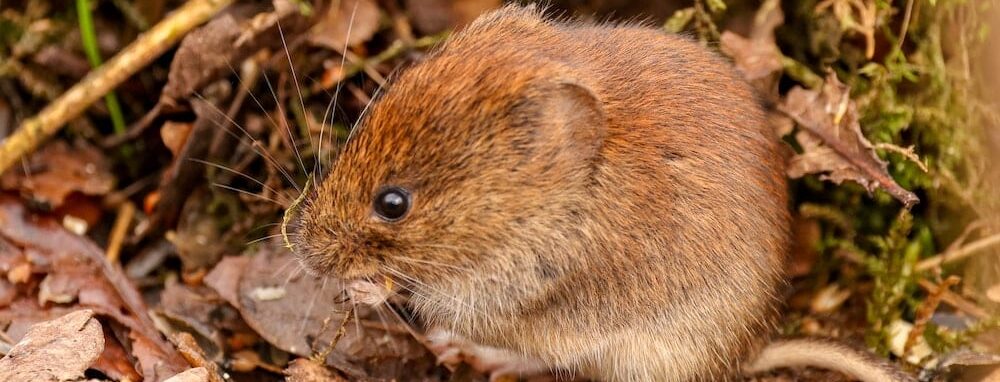
Garden voles: how to control, trap & prevent them
Have you discovered voles in your garden? They might be cute little balls of fur, but they can cause a lot of damage. So, while we shouldn’t immediately rush out and buy poison for garden voles, we can drive them away without killing them. Garden voles burrow underground and feed on your lawn’s roots, so […]
🌱 All important maintenance moments for your lawn during the year. Leave your email and we will send you the lawn calendar for free.
Enter your email
Receive the lawn calendar in the mail
Enjoy a green lawn all year round!

- Order by 2PM = shipped today
- 250.000+ satisfied customers!
- 60 day satisfaction guarantee
Have you discovered voles in your garden? They might be cute little balls of fur, but they can cause a lot of damage. So, while we shouldn’t immediately rush out and buy poison for garden voles, we can drive them away without killing them.
- What are garden voles?
- How to identify garden voles
- Garden voles LOVE your garden
- Garden voles are always active
- How garden voles damage your lawn
- How to control voles in your garden
- Scare the voles with ultrasound
- Repel garden voles with strong odours
- Use natural predators to scare your garden voles
- Catch garden voles with a trap
- Kill voles with poison
- How to prevent voles from moving into your garden
- How do I repair my lawn after a vole invasion?
- FAQs
Garden voles burrow underground and feed on your lawn’s roots, so if you can discourage them, you should. Because, after all, you put a lot of time and love into your lawn. It can be particularly annoying when little mounds and bare patches appear.
This article is about how to eradicate garden voles naturally so you can enjoy your lawn for the long term.
What are garden voles?
A vole is a collective term for various underground mice. Three vole species live in the UK:
- Bank Voles
- Field Voles
- Water Voles
They’re similar in appearance and often mistaken for rats.
Garden voles burrow underground and cause swift damage to a lawn because they feed on the roots.
However:
Don’t confuse voles with moles, which are often a sign of a healthy lawn with well-aerated soil. Moles eat lawn-damaging grubs, so they’re generally more welcome than voles (unless they build their molehills across your lawn, of course).
Voles offer a whole different world of disruption because, while moles are solitaire animals, voles are community beasts, spreading quickly. In fact, from April to October, a vole can have three to four litters with up to seven babies each time!
So, in no time, your garden gets infested with voles.
How to identify garden voles
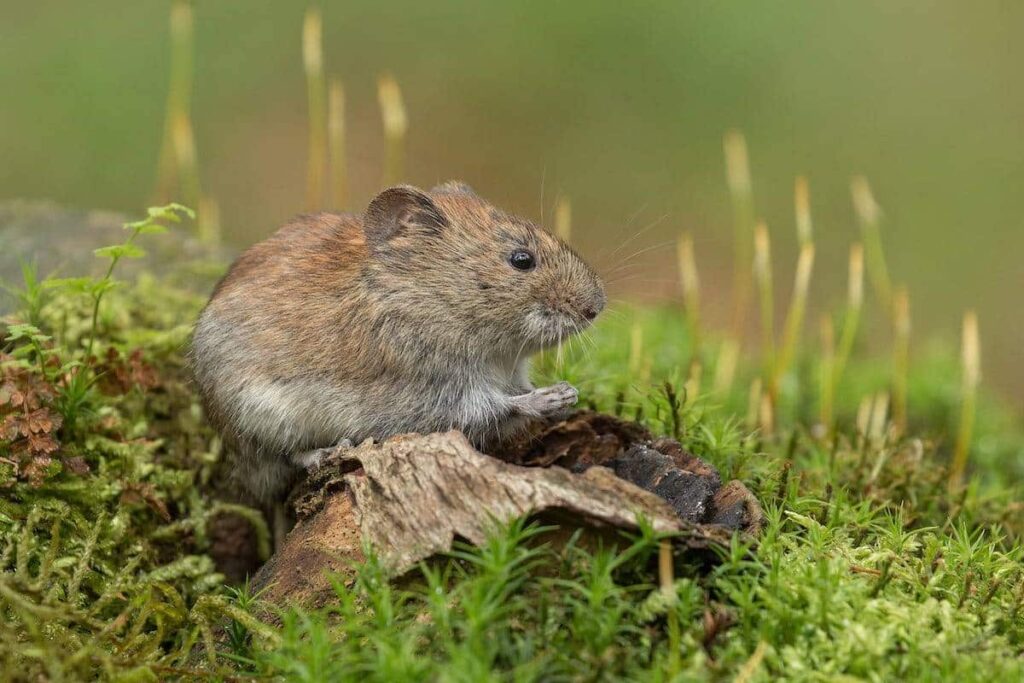
Voles are 8-10cm long, with a round, stocky body and little hairy legs. Their tail can be as long as 7cm. They have thick fur that ranges from light brown to grey, depending on the species.
Garden voles travel underneath, creating complex networks of labyrinthine tunnels close to the surface.
Their favourite food is — shock horror — blades of grass and roots. So, a vole infestation is rarely welcomed.
Garden voles LOVE your garden
Voles feel right at home in your garden because they love damp underground soil with high levels of vegetation (i.e., your garden and lawn).
You’ll also see them around drainage pipes, on roadsides, and foraging around refuse waste sites. And while voles are considered omnivores, they mainly feast on grass stems and blades.
Garden voles are always active
Voles forage for food all year round. They’re nocturnal during the warmer months, during which they love nothing more than to munch on well-watered roots.
However, when your lawn goes dormant during the winter, voles are forced to scurry around above ground in search of food.
How garden voles damage your lawn
Voles are typically vegetarian, although they will eat anything if they need to. They love:
- Jerusalem artichokes
- Parsnips
- Celery
- Tulip bulls
- Young fruit trees, and
- Grass roots, stems, and blades
They create extended networks of tunnels underground, which damages your lawn’s roots — hence the yellow and bald spots that appear on your turf during an infestation. They also create little mounds, like tiny molehills, which are less prevalent.
If you’re unsure whether you have moles or voles, check out my articles about how to control moles in your garden.
How to control voles in your garden
There are several ways to control or scare away voles from your garden. I always recommend the animal-friendly, humane approaches, but there are other more nuclear alternatives you might consider.
Catching live garden voles
The most humane way to repel voles is to capture and release them alive. Granted, this method takes some patience and effort, but it’s the kinder way of tackling the problem. We’re all part of the broader cycle of life, after all.
Moles traps are effective ways to catch the furry little feckers. See if you can find routes that your voles have been using extensively and place the traps there.
Voles have very sensitive noses, so wear gloves while you handle the trap; otherwise, they’ll detect your scent and steer clear. Rub the trap with soil to remove any trace of your scent.
Alternatively, add a tiny piece of carrot or celery inside the trap — that will grab their attention!
Find a location at least 1km away (and clear of other gardens), then release the vole from the mole trap. Keep a regular eye on the trap because they’ll starve quickly if you leave them too long. Avoid transferring them to another box — it will stress the poor little thing.
If you have a large garden, use four traps per 100 square metres.
Scare the voles with ultrasound
Another way to gently scare voles away is to use an ultrasonic mole deterrent. These emit underground vibrations that disturb the peace and quiet that voles and moles seek. The constant vibrations make it difficult for rodents to communicate, which sends them packing to somewhere calmer and more restful.
Ultrasonic deterrents can take around two weeks to work their magic, so be patient. Also, consider the size of your lawn — check the area the deterrent covers and ensure you’re not just sending your voles to another location within your garden. The ultrasound needs to reach each corner to ensure your garden voles get packing.
Repel garden voles with strong odours
Like moles, voles hate strong smells, so consider planting strongly scented plants to deter them from making your garden their home.
You could plant:
- Garlic
- Daffodils
- Grape hyacinth
- Hellebores
- Salvia
- Iris
- Snowdrops
Also, it might seem odd, but voles dislike human hair and buttermilk. So, uncover the little mounds in your lawn and fill the hole with the contents of your hairbrush, along with a healthy portion of buttermilk.
Then, press the mounds down firmly, and the voles will scatter.
Use natural predators to scare your garden voles

This is where your cat can earn their keep. And while they’re likely to gift you their conquests, cats are particularly effective in the battle against small garden rodents.
And while cats don’t eat the voles, they will play with them — and usually, the rough and tumble of a cat game will see the vole off for good.
Catch garden voles with a trap
Mouse traps are a cheap and effective way to combat your garden’s rodent population. However, leave your mouse traps where children or pets aren’t likely to injure themselves.
Lure voles to your mouse traps with celery and carrots. And while a mouse trap is a fairly horrible way for the vole to meet its maker, it’s undoubtedly an effective way to deal with the problem.
But I’d always recommend more humane approaches to tackle the problem wherever possible.
Kill voles with poison
Perhaps the quickest way to deal with the problem is to hire an expert to lay down poison. You should consider this option as a last resort and avoid administering poison yourself; otherwise, you could harm your pets or other wildlife.
How to prevent voles from moving into your garden

Once you’ve tackled your garden vole infestation, you’ll want to ensure they stay away.
Here are our top tips to prevent them from returning:
- Mow your lawn regularly to keep it short
- Voles love weeds, so keep your garden and lawn weed free. Remove root weeds as soon as you notice them.
- While wild grasses are beneficial for the insect population, try and limit the number you’re growing.
- Dense vegetation provides excellent protection for nesting voles, so keep your flowerbeds in good shape and clear of creeping weeds.
- Keep water points clean.
- Cover water drainage pipes with chicken wire to stop voles from setting up home!
- Plant strong-smelling plants and flowers, like crown imperial, garlic, and hyacinths, to repel garden voles and other small rodents, including moles
How do I repair my lawn after a vole invasion?
Your lawn is probably in a bit of a state after a vole invasion. So, it will be time to renovate and restore your grass plants to their former beauty.
The big problem is the network of tunnels underneath your lawn — they’ll close up eventually, but in the meantime, other rodents may discover the network and move in.
So, fill as many tunnels as possible by pushing existing vole mounds back into the ground.
Then, aerate your lawn with a hollow-tined aerator:
- Remove leaves, pebbles, and other lawn debris.
- Mow your lawn to around 4cm.
- Punch holes into your lawn with your hollow tine aerator — these usually sink deep enough to reach the upper tunnels.
- Fill the holes with fresh topsoil. This interrupts the tunnel network and encourages new root growth.
- Overseed with premium lawn seed and apply Lawn Starter fertiliser.
- Press the seeds into the soil to ensure good contact — they won’t germinate without good contact. Keep the soil moist for 14 days.
- Remove weeds as soon as they appear, and avoid walking on the new grass plants until after the first mowing.
Any questions?
We hope you’ve got all the information you’ll need to tackle a vole invasion in your garden. But if you have questions, don’t hesitate to contact us.
And we’ll get back to you as soon as we can.
Thanks for reading!
FAQs
Voles are always looking for water sources and succulent roots. That’s why you often find them near ponds, rubbish tips, canals, and well-tended gardens.
How do you identify a garden vole invasion?
Like moles, you can spot voles by little mounds of earth that appear across your soil. Vole hills are smaller than molehills. You’ll also spot yellow or bald spots in your lawn, with areas of dying grass.
Why do I have voles in my garden?
Voles are typically vegetarian and prefer to feed on succulent roots and tubers. And if you take good care of your lawn, it will attract voles and other small rodents. So, well done you for looking after your lawn, but it might be time to tackle the infestation.
-
Orchids: A Complete Guide on How to Care for ThemWant to give your orchid the best possible care? Discover essential tips from placement to watering and pruning. Learn everything you need to know!Read more
-
Growing Wisteria Made Simple: From Planting to Perfect BloomsWith blossoms like a purple waterfall, Wisteria sets an almost magical and colourful mood. If you want to grow this beauty in your garden, you’ll need a bit of patience. Don’t worry, it will most definitely pay off.Read more
-
How to Build a DIY Greenhouse: A Practical Guide for Smart SpendersImagine extending your growing season throughout the year, nurturing tender plants regardless of the weather, and creating a personal garden sanctuary. This is precisely what a DIY greenhouse offers you. Let’s learn how to build one.Read more
-
How to Grow Eucalyptus in British GardensWith a little love and care, eucalyptus trees can thrive in English gardens. Since they don’t germinate well without proper help, there are not considered invasive. So, there is no reason not to plant them if you enjoy their looks.Read more
-
Transform Your Garden with All-Year-Round Flowering PlantsDid you know you can enjoy blooming flowers even in January? With the right selection of all year round plants, there’s no need to wait until spring to add some colour to your garden.Read more
-
How to Create a Butterfly Garden: A Simple Guide for British GardensThe UK's butterfly population includes 59 different species. These beautiful winged creatures face a steady decline because of habitat loss, pollution and changing weather patterns. Your garden can become a vital link between nature reserves and natural habitats. Let’s explore how.Read more
-
Volcanic Rock Dust for Your Garden—Application and TipsDid you know that volcanic rock dust is a brilliant organic soil improver? This article explains exactly what it's good for and how to use it properly.Read more
-
How to Use Landscape Fabric ProperlyIf weeds or erosion in your garden are troubling you, landscape fabric might be the solution. We’ll explain how and when to use it properly, just keep on reading.Read more
Leave a comment
Your answer will be displayed on the site and the interested party will be notified by email.
Leave a comment
Have a question or want to share your experience? Leave us a comment.

- Order by 2PM = shipped today
- 250.000+ satisfied customers!
- 60 day satisfaction guarantee

- Order by 2PM = shipped today
- 250.000+ satisfied customers!
- 60 day satisfaction guarantee

🌱 All important maintenance moments for your lawn during the year. Leave your email and we will send you the lawn calendar for free.
Enter your email
Receive the lawn calendar in the mail
Enjoy a green lawn all year round!



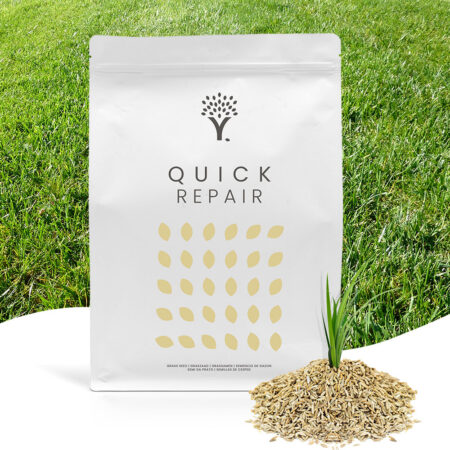
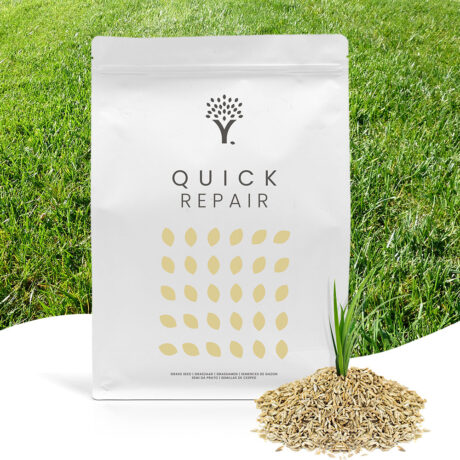
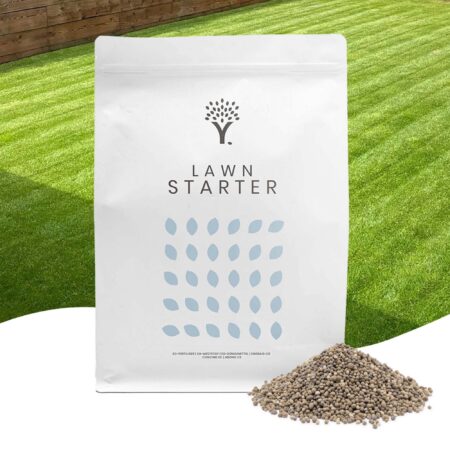
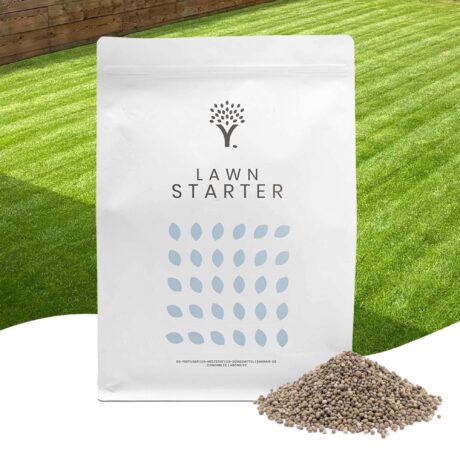



















Comments (0)
There are no comments yet. Well then, what are you waiting for to
Be the first to write your comment!inaugurate this pretty page?
Do you have some comments?